YAMAHA DT125R 2002 Workshop Manual
Manufacturer: YAMAHA, Model Year: 2002, Model line: DT125R, Model: YAMAHA DT125R 2002Pages: 96, PDF Size: 2.14 MB
Page 51 of 96
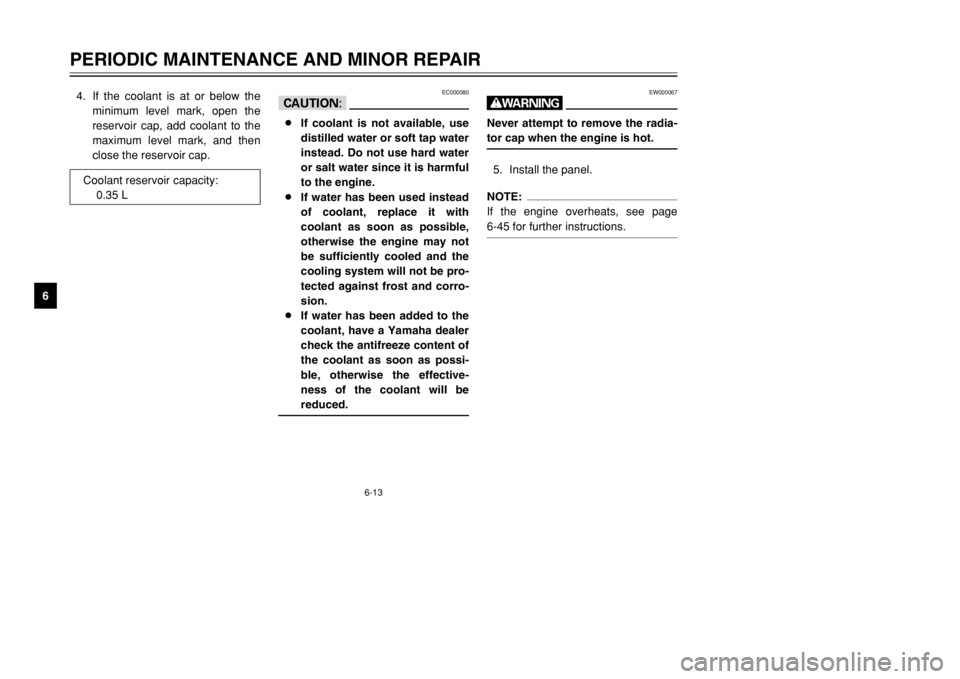
6-13
PERIODIC MAINTENANCE AND MINOR REPAIR
64. If the coolant is at or below the
minimum level mark, open the
reservoir cap, add coolant to the
maximum level mark, and then
close the reservoir cap.
EW000067
wNever attempt to remove the radia-
tor cap when the engine is hot.5. Install the panel.NOTE:
If the engine overheats, see page
6-45 for further instructions.
EC000080
cC8If coolant is not available, use
distilled water or soft tap water
instead. Do not use hard water
or salt water since it is harmful
to the engine.
8If water has been used instead
of coolant, replace it with
coolant as soon as possible,
otherwise the engine may not
be sufficiently cooled and the
cooling system will not be pro-
tected against frost and corro-
sion.
8If water has been added to the
coolant, have a Yamaha dealer
check the antifreeze content of
the coolant as soon as possi-
ble, otherwise the effective-
ness of the coolant will be
reduced.
Coolant reservoir capacity:
0.35 L
3MB-9-E8 6/13/01 10:55 AM Page 50
Page 52 of 96
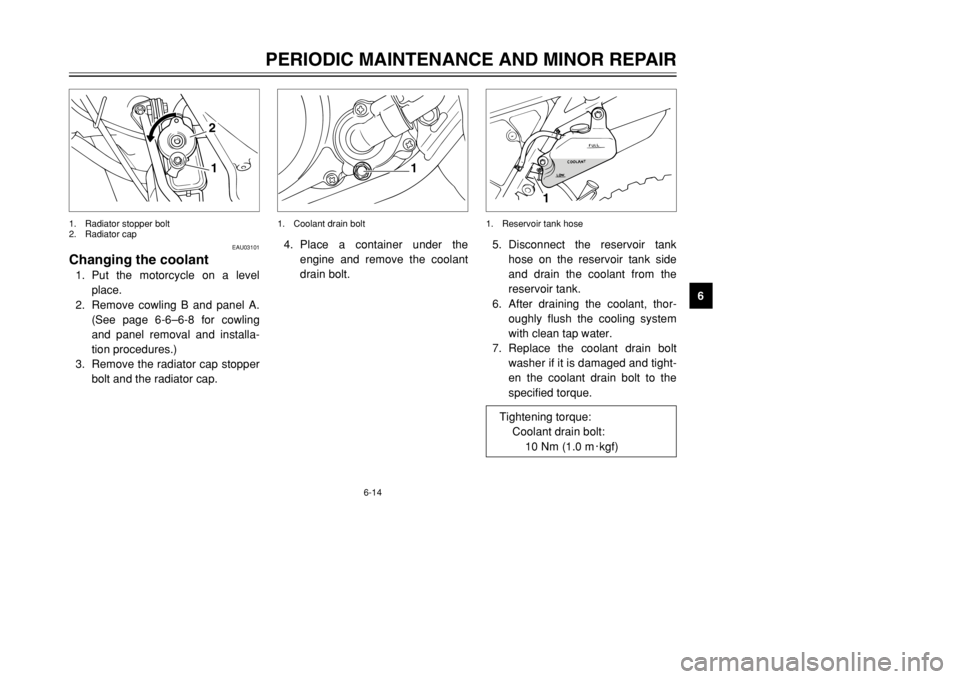
6-14
PERIODIC MAINTENANCE AND MINOR REPAIR
6
EAU03101
Changing the coolant1. Put the motorcycle on a level
place.
2. Remove cowling B and panel A.
(See page 6-6–6-8 for cowling
and panel removal and installa-
tion procedures.)
3. Remove the radiator cap stopper
bolt and the radiator cap.
12
1. Radiator stopper bolt
2. Radiator cap
5. Disconnect the reservoir tank
hose on the reservoir tank side
and drain the coolant from the
reservoir tank.
6. After draining the coolant, thor-
oughly flush the cooling system
with clean tap water.
7. Replace the coolant drain bolt
washer if it is damaged and tight-
en the coolant drain bolt to the
specified torque.
1
1. Reservoir tank hose
4. Place a container under the
engine and remove the coolant
drain bolt.
1
1. Coolant drain bolt
Tightening torque:
Coolant drain bolt:
10 Nm (1.0 m0kgf)
3MB-9-E8 6/13/01 10:55 AM Page 51
Page 53 of 96
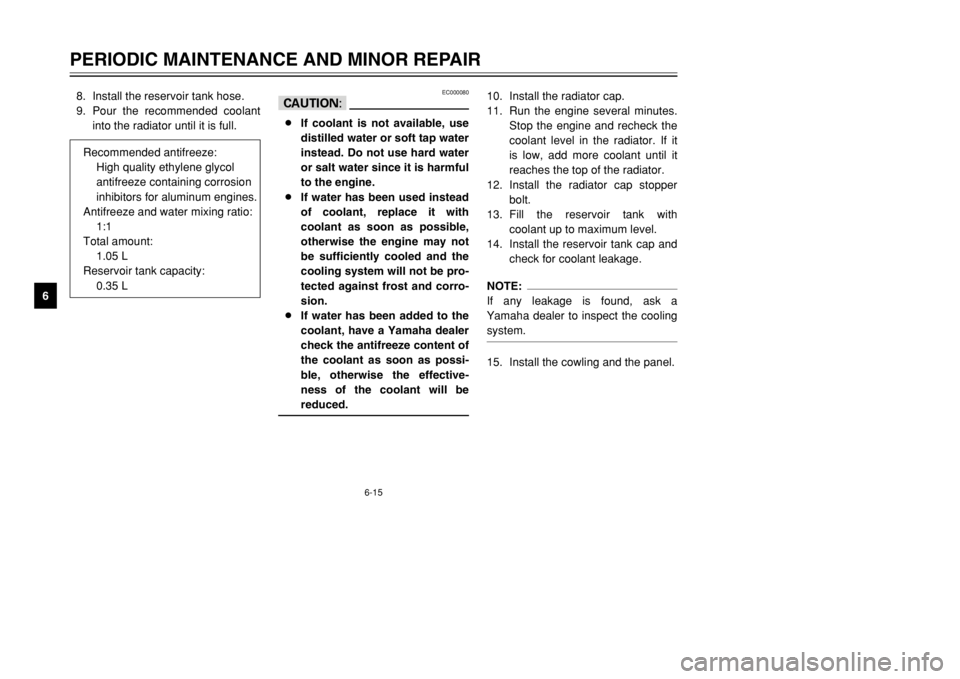
6-15
PERIODIC MAINTENANCE AND MINOR REPAIR
68. Install the reservoir tank hose.
9. Pour the recommended coolant
into the radiator until it is full.10. Install the radiator cap.
11. Run the engine several minutes.
Stop the engine and recheck the
coolant level in the radiator. If it
is low, add more coolant until it
reaches the top of the radiator.
12. Install the radiator cap stopper
bolt.
13. Fill the reservoir tank with
coolant up to maximum level.
14. Install the reservoir tank cap and
check for coolant leakage.
NOTE:
If any leakage is found, ask a
Yamaha dealer to inspect the cooling
system.15. Install the cowling and the panel.
EC000080
cC8If coolant is not available, use
distilled water or soft tap water
instead. Do not use hard water
or salt water since it is harmful
to the engine.
8If water has been used instead
of coolant, replace it with
coolant as soon as possible,
otherwise the engine may not
be sufficiently cooled and the
cooling system will not be pro-
tected against frost and corro-
sion.
8If water has been added to the
coolant, have a Yamaha dealer
check the antifreeze content of
the coolant as soon as possi-
ble, otherwise the effective-
ness of the coolant will be
reduced.
Recommended antifreeze:
High quality ethylene glycol
antifreeze containing corrosion
inhibitors for aluminum engines.
Antifreeze and water mixing ratio:
1:1
Total amount:
1.05 L
Reservoir tank capacity:
0.35 L
3MB-9-E8 6/13/01 10:55 AM Page 52
Page 54 of 96
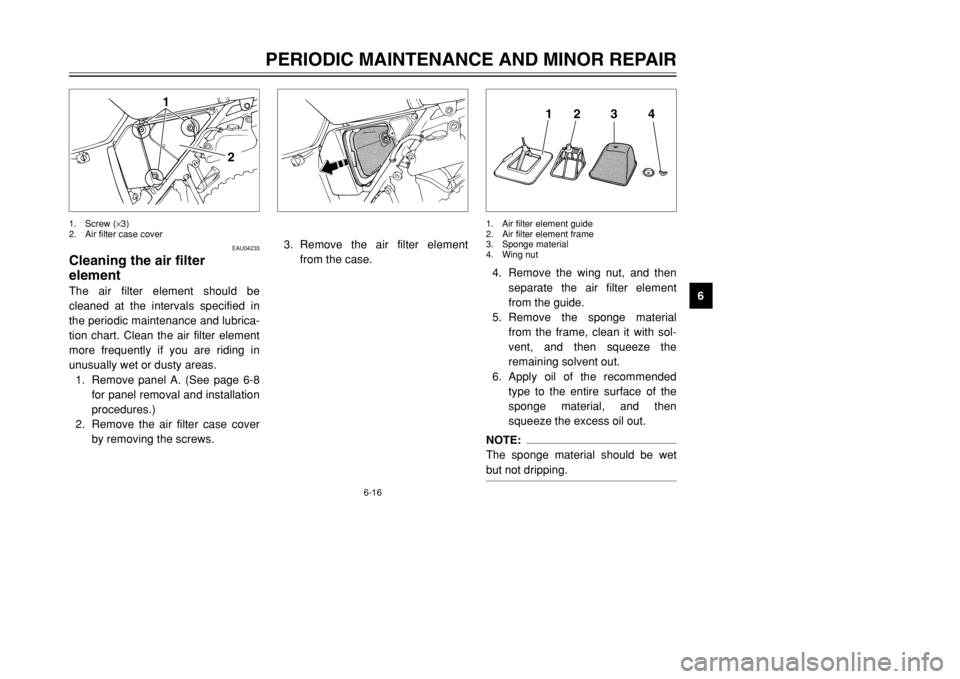
6-16
PERIODIC MAINTENANCE AND MINOR REPAIR
6
EAU04233
Cleaning the air filter
elementThe air filter element should be
cleaned at the intervals specified in
the periodic maintenance and lubrica-
tion chart. Clean the air filter element
more frequently if you are riding in
unusually wet or dusty areas.
1. Remove panel A. (See page 6-8
for panel removal and installation
procedures.)
2. Remove the air filter case cover
by removing the screws.��
1
2
1. Screw (×3)
2. Air filter case cover
4. Remove the wing nut, and then
separate the air filter element
from the guide.
5. Remove the sponge material
from the frame, clean it with sol-
vent, and then squeeze the
remaining solvent out.
6. Apply oil of the recommended
type to the entire surface of the
sponge material, and then
squeeze the excess oil out.NOTE:
The sponge material should be wet
but not dripping.
12
3
4
1. Air filter element guide
2. Air filter element frame
3. Sponge material
4. Wing nut
3. Remove the air filter element
from the case.
3MB-9-E8 6/13/01 10:55 AM Page 53
Page 55 of 96

6-17
PERIODIC MAINTENANCE AND MINOR REPAIR
67. Pull the sponge material over the
frame.
8. Install the air filter element onto
the guide, and then tighten the
wing nut.
9. Insert the air filter element into
the case.
10. Install the air filter case cover by
installing the screws.
11. Install the panel.
EC000082
cC8Make sure that the air filter ele-
ment is properly seated in the
air filter case.
8The engine should never be
operated without the air filter
element installed, otherwise
the piston and/or cylinder may
become excessively worn.
EAU00632
Adjusting the engine idling
speedThe engine idling speed must be
checked and, if necessary, adjusted
as follows at the intervals specified in
the periodic maintenance and lubrica-
tion chart.
1. Start the engine and warm it up
for several minutes at 1,000–
2,000 r/min while occasionally
revving it to 4,000–5,000 r/min.NOTE:
The engine is warm when it quickly
responds to the throttle.2. Check the engine idling speed
and, if necessary, adjust it to
specification by turning the throt-
tle stop screw.
EAU00629
Adjusting the carburetorThe carburetor is an important part of
the engine and requires very sophisti-
cated adjustment. Therefore, most
carburetor adjustments should be left
to a Yamaha dealer, who has the
necessary professional knowledge
and experience. The adjustment
described in the following section,
however, may be serviced by the
owner as part of routine mainte-
nance.
EC000094
cCThe carburetor has been set and
extensively tested at the Yamaha
factory. Changing these settings
without sufficient technical knowl-
edge may result in poor perfor-
mance of or damage to the engine.
Recommended oil:
2-stroke engine oil
3MB-9-E8 6/13/01 10:55 AM Page 54
Page 56 of 96
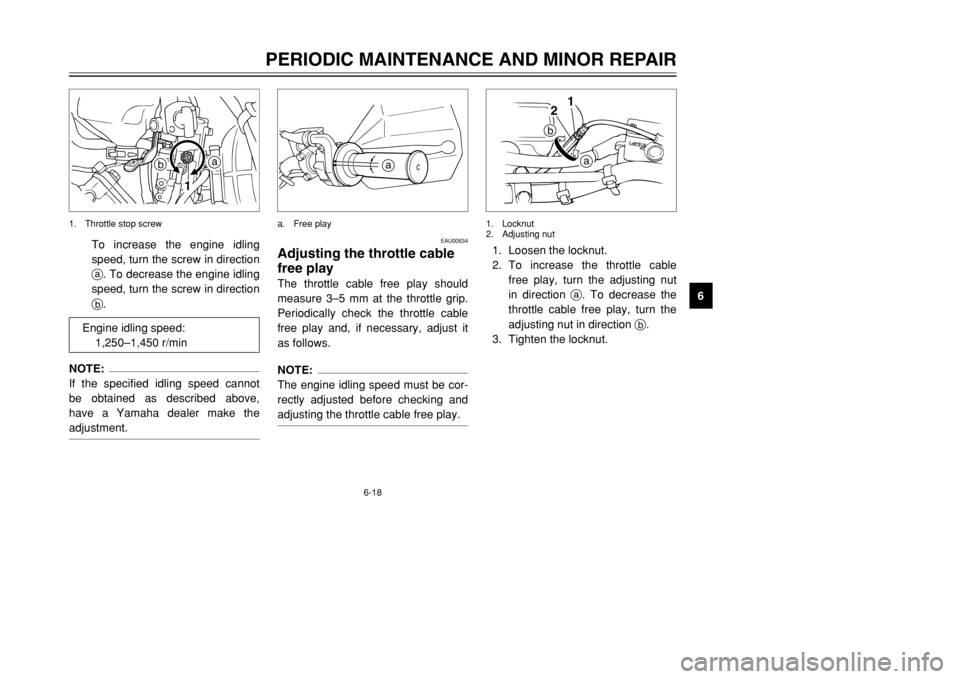
6-18
PERIODIC MAINTENANCE AND MINOR REPAIR
6
b
a
1
1. Throttle stop screw
To increase the engine idling
speed, turn the screw in direction
a. To decrease the engine idling
speed, turn the screw in direction
b.
NOTE:
If the specified idling speed cannot
be obtained as described above,
have a Yamaha dealer make the
adjustment.
EAU00634
Adjusting the throttle cable
free playThe throttle cable free play should
measure 3–5 mm at the throttle grip.
Periodically check the throttle cable
free play and, if necessary, adjust it
as follows.NOTE:
The engine idling speed must be cor-
rectly adjusted before checking and
adjusting the throttle cable free play.
a
a. Free play
Engine idling speed:
1,250–1,450 r/min
1. Loosen the locknut.
2. To increase the throttle cable
free play, turn the adjusting nut
in direction a. To decrease the
throttle cable free play, turn the
adjusting nut in direction b.
3. Tighten the locknut.
2
1
b
a
1. Locknut
2. Adjusting nut
3MB-9-E8 6/13/01 10:55 AM Page 55
Page 57 of 96

6-19
PERIODIC MAINTENANCE AND MINOR REPAIR
6
EAU04259
TiresTo maximize the performance, dura-
bility, and safe operation of your
motorcycle, note the following points
regarding the specified tires.
Tire air pressure
The tire air pressure should be
checked and, if necessary, adjusted
before each ride.
EW000082
w8The tire air pressure must be
checked and adjusted on cold
tires (i.e., when the tempera-
ture of the tires equals the
ambient temperature).
8The tire air pressure must be
adjusted in accordance with
the riding speed and with the
total weight of rider, passen-
ger, cargo, and accessories
approved for this model.
8NEVER OVERLOAD THE
MOTORCYCLE! Operation of
an overloaded motorcycle may
result in tire damage, loss of
control, or severe injury. Make
sure that the total weight of
rider, passenger, cargo, and
accessories does not exceed
the specified maximum load
for the vehicle.
8Do not carry along loosely
packed items, which can shift
during a ride.
8Securely pack the heaviest
items close to the center of the
motorcycle and distribute the
weight evenly on both sides.
8Adjust the suspension and tire
air pressure with regard to the
load.
8Check the tire condition and
air pressure before each ride.
EWA00012
wBecause loading has an enormous
impact on the handling, braking,
performance and safety character-
istics of your motorcycle, you
should keep the following precau-
tions in mind.
Tire air pressure
(measured on cold tires)
Load* Front Rear
Up to 90 kg125 kPa
(1.25 kgf/cm
2,
1.25 bar)150 kPa
(1.50 kgf/cm
2,
1.50 bar)
90 kg–
maximum150 kPa
(1.50 kgf/cm
2,
1.50 bar175 kPa
(1.75 kgf/cm
2,
1.75 bar)
Off-road riding125 kPa
(1.25 kgf/cm
2,
1.25 bar)150 kPa
(1.50 kgf/cm
2,
1.50 bar)
Maximum load*180 kg
178 kg (CH, A only)
* Total weight of rider, passenger, cargo and
accessories
3MB-9-E8 6/13/01 10:55 AM Page 56
Page 58 of 96
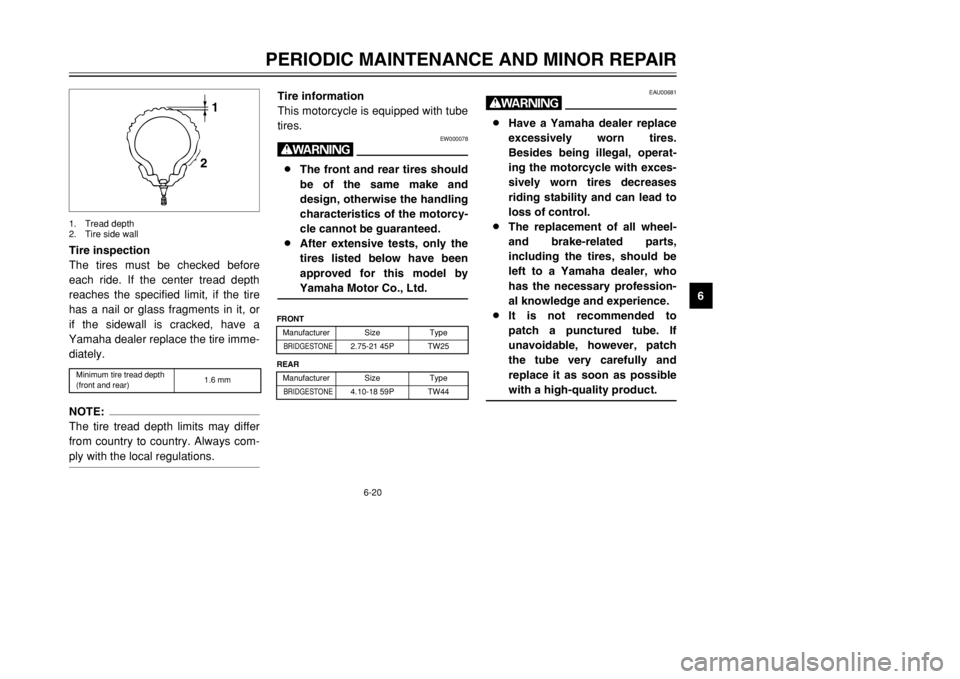
6-20
PERIODIC MAINTENANCE AND MINOR REPAIR
6 Tire inspection
The tires must be checked before
each ride. If the center tread depth
reaches the specified limit, if the tire
has a nail or glass fragments in it, or
if the sidewall is cracked, have a
Yamaha dealer replace the tire imme-
diately.
NOTE:
The tire tread depth limits may differ
from country to country. Always com-
ply with the local regulations.
1
2
1. Tread depth
2. Tire side wall
EAU00681
w8Have a Yamaha dealer replace
excessively worn tires.
Besides being illegal, operat-
ing the motorcycle with exces-
sively worn tires decreases
riding stability and can lead to
loss of control.
8The replacement of all wheel-
and brake-related parts,
including the tires, should be
left to a Yamaha dealer, who
has the necessary profession-
al knowledge and experience.
8It is not recommended to
patch a punctured tube. If
unavoidable, however, patch
the tube very carefully and
replace it as soon as possible
with a high-quality product.
Tire information
This motorcycle is equipped with tube
tires.
EW000078
w8The front and rear tires should
be of the same make and
design, otherwise the handling
characteristics of the motorcy-
cle cannot be guaranteed.
8After extensive tests, only the
tires listed below have been
approved for this model by
Yamaha Motor Co., Ltd.
Minimum tire tread depth
(front and rear)1.6 mm
FRONT
Manufacturer Size TypeBRIDGESTONE
2.75-21 45P TW25
REAR
Manufacturer Size Type
BRIDGESTONE
4.10-18 59P TW44
3MB-9-E8 6/13/01 10:55 AM Page 57
Page 59 of 96

6-21
PERIODIC MAINTENANCE AND MINOR REPAIR
6
EAU00685
Spoke wheelsTo maximize the performance, dura-
bility, and safe operation of your
motorcycle, note the following points
regarding the specified wheels.
8The wheel rims should be
checked for cracks, bends or
warpage, and the spokes for
looseness or damage before
each ride. If any damage is
found, have a Yamaha dealer
replace the wheel. Do not
attempt even the smallest repair
to the wheel. A deformed or
cracked wheel must be replaced.
8The wheel should be balanced
whenever either the tire or wheel
has been changed or replaced.
An unbalanced wheel can result
in poor performance, adverse
handling characteristics, and a
shortened tire life. 8Ride at moderate speeds after
changing a tire since the tire sur-
face must first be “broken in” for
it to develop its optimal charac-
teristics.
3MB-9-E8 6/13/01 10:55 AM Page 58
Page 60 of 96
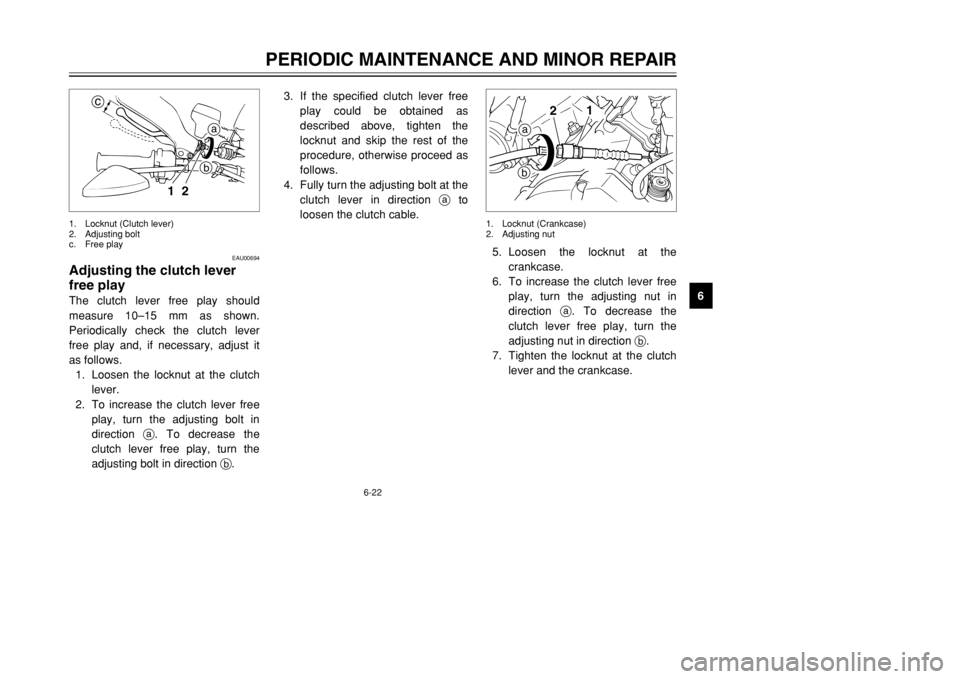
6-22
PERIODIC MAINTENANCE AND MINOR REPAIR
6
EAU00694
Adjusting the clutch lever
free playThe clutch lever free play should
measure 10–15 mm as shown.
Periodically check the clutch lever
free play and, if necessary, adjust it
as follows.
1. Loosen the locknut at the clutch
lever.
2. To increase the clutch lever free
play, turn the adjusting bolt in
direction a. To decrease the
clutch lever free play, turn the
adjusting bolt in direction b.
12b
a c
1. Locknut (Clutch lever)
2. Adjusting bolt
c. Free play
5. Loosen the locknut at the
crankcase.
6. To increase the clutch lever free
play, turn the adjusting nut in
direction a. To decrease the
clutch lever free play, turn the
adjusting nut in direction b.
7. Tighten the locknut at the clutch
lever and the crankcase.
a
21
b
1. Locknut (Crankcase)
2. Adjusting nut
3. If the specified clutch lever free
play could be obtained as
described above, tighten the
locknut and skip the rest of the
procedure, otherwise proceed as
follows.
4. Fully turn the adjusting bolt at the
clutch lever in direction ato
loosen the clutch cable.
3MB-9-E8 6/13/01 10:55 AM Page 59